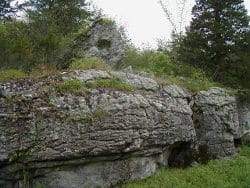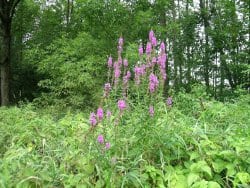by Julie Richburg
As regional ecologist for The Trustees of Reservations, I work with my colleagues to ensure that the natural resources of our properties (including rare species) are protected from threats such as erosion, non-native invasive plants, and inappropriate use. With more than 40 properties within my region totaling nearly 10,000 acres, we must prioritize what gets done. Non-native invasive plants are found on nearly every property in Massachusetts, at least at some level, and are often regarded as one of the greatest threats to the native habitats and species on our properties. So where do we start? At The Trustees, we have been taking a careful and deliberate look at where to use our resources (staff, volunteers, and financial) to control invasive plants, using our Invasive Plant Management Guidelines. The following is one case study that illustrates how we use this tool to structure our priorities.
Preserving a Landmark
Bartholomew’s Cobble, a National Natural Landmark, lies along the Housatonic River in Sheffield, Massachusetts and has long been recognized as a place of outstanding ecological, scenic, and recreational value. The 330-acre reservation includes agricultural fields, rock outcrops, wetlands, floodplain forests, and woodlands. It is home to many state-listed species, many of which are specialists on the Cobbles’ calcareous soils or in its floodplain habitats. About ten years ago, we began to realize that the very species that we were most concerned with protecting were being lost amongst an ever increasing population of invasive species including Japanese barberry, garlic mustard, and common buckthorn.

Bartholomew's Cobble is home to many state-listed species that, in 2003, were being lost to invasives. South Cobble became a high-priority area for resource allocation.
In 2003, we conducted a survey of the plants of the Cobble with an emphasis on relocating rare and unusual species, mapping plant communities, and assessing the effect of invasive species on rare plants and communities. Since we were new to invasive plant control, we began a slow and careful attempt to rid key invasive plants from sections of the property using a small but dedicated cadre of staff and volunteers. As we gained confidence that we could control the invasives without negatively impacting the species we were trying to protect, we increased our efforts from only hand-pulling, to cutting woody shrubs and painting the stumps with herbicide, and eventually even doing some foliar spray.

Invasive species are ranked and prioritized in different areas to give clear indication of where to apply resources.
Devising a Plan – and Sticking to It!
As we began to see success with these control projects, we slowly expanded our efforts to include more of the property and more species. In 2009, we completed an Invasive Plant Management Plan for the entire 330 acre reservation to serve as a roadmap for our staff and volunteers to continue our focus on the most important features of the reservation. Significantly, the plan designates areas or species that we will NOT try to control. In the case of Bartholomew’s Cobble, the area of active management is narrowed to the 85 acres surrounding our most important rare species. Making a deliberate decision to walk away from a part of the property is very difficult, especially for those staff working at the Cobble daily. Yet with limited resources and many properties to work on, there needs to be a balance between what can get done and what needs to be left alone and having a written plan keeps everyone on task. The plan also serves to record our successes and the resources that were required to achieve those successes so that the information can be factored into future efforts.
Whether you are managing a large piece of conservation land, or just your own backyard you can effectively manage invasive plants by following a few key guidelines.
1) Identify what you want. This often gets lost in the rush to get rid of the undesirable invasives. In our case, we wanted to protect rare species, but you may want to see more butterflies or have more bird habitat.
2) Learn about the biology of species you want to get rid of, aka know your enemy. Is the plant shade tolerant? Spread by rhizomes? Does it like its feet wet? Also, what is the size of the infestation and where is it? All of these will influence how to control the species.
3) Develop a reasonable timeline and be realistic. Very few invasive plant control efforts completely eradicate a species (especially if your neighbor has a large burning bush that sends new seeds your way every year). A little persistence and a keen eye can catch seedlings before they get out of hand and make it easier to maintain the habitat the way you want it – and don’t we all want a good excuse to spend time closely observing our favorite places!
About the Author
Julie Richburg, PhD, is the Regional Ecologist for The Trustees of Reservations (a state-wide non-profit land trust) Western Region in MA. She oversees natural resource inventory and management for the 40 properties (approx. 9,000 acres) owned or managed by The Trustees. While at UMass Amherst, Dr. Richburg’s research focused on control of woody invasive plants using mechanical and prescribed fire treatments across the Northeast. In 2008, she wrote “Invasive Plant Management: Guidelines for Managers” which includes guidelines for prioritizing invasive plant management by property or region. In 2009, she organized a partnership of individuals, organizations, and agencies interested in invasive species control within the Westfield River Watershed. She may be reached at jrichburg@ttor.org.

